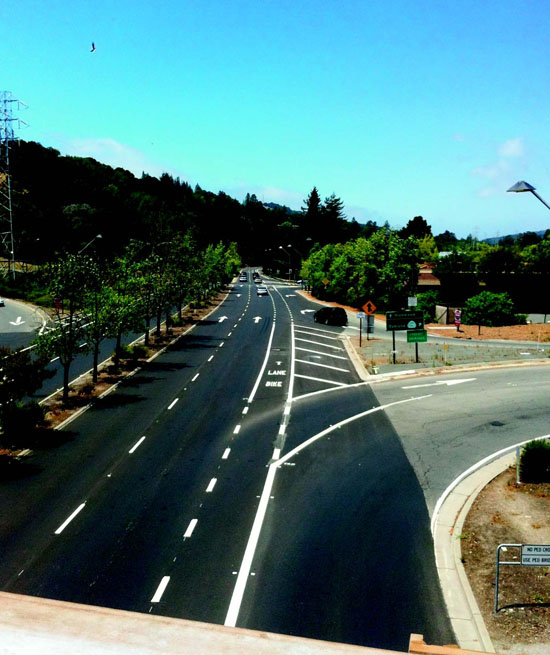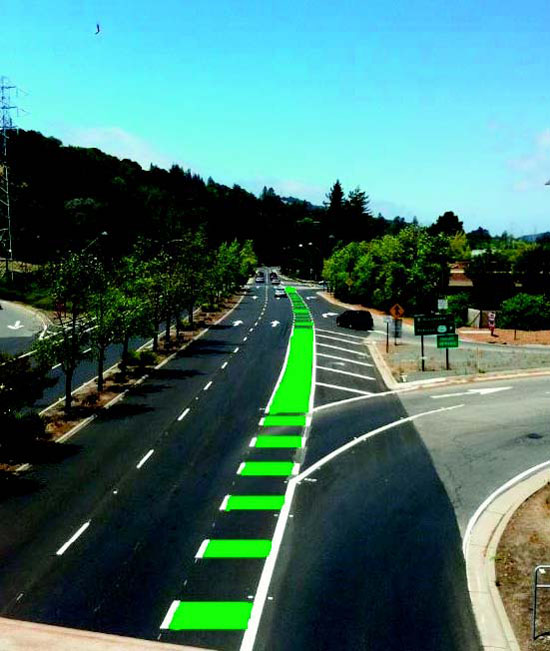 |
|
|
Bike lane along Camino Pablo Road as it is today. Photos courtesy City of Orinda
|
|
|
|
|
|
Green is the color of caution if you are driving alongside a bike lane, but adding that color to the bike lane surface may not be sufficient to protect bicyclists in the view of some. The issue has come to the fore in Orinda as part of the question of how to complete the design of the recently striped northbound bike lane beneath BART and Highway 24 on Camino Pablo Road.
 The current design is a "death trap" in the view of Bill Cooper, a 20-year cyclist who wrote to Lamorinda Weekly to protest the current configuration of the bike lane. It is now a "meat grinder" sandwiched between two lanes that turn right onto westbound Highway 24, inviting disaster when a motorist turning across the lane crosses the path of a biker heading straight on the new bike lane. The subject of improving the design is expected to come before the Orinda City Council at its Aug. 18 meeting, and the public is encouraged to attend.
The current design is a "death trap" in the view of Bill Cooper, a 20-year cyclist who wrote to Lamorinda Weekly to protest the current configuration of the bike lane. It is now a "meat grinder" sandwiched between two lanes that turn right onto westbound Highway 24, inviting disaster when a motorist turning across the lane crosses the path of a biker heading straight on the new bike lane. The subject of improving the design is expected to come before the Orinda City Council at its Aug. 18 meeting, and the public is encouraged to attend.
 Why have a bike lane at all, when there is a perfectly good concrete sidewalk running adjacent to the roadway and crossing the Highway 24 on-ramp on its own bridge? "Bikers have a right to use the roadway," explains Orinda Senior Engineer Larry Theis. "And it is not a good idea to mix bikers and pedestrians anyway."
Why have a bike lane at all, when there is a perfectly good concrete sidewalk running adjacent to the roadway and crossing the Highway 24 on-ramp on its own bridge? "Bikers have a right to use the roadway," explains Orinda Senior Engineer Larry Theis. "And it is not a good idea to mix bikers and pedestrians anyway."
 So, given the fact that the bike lane seems to be fait accompli, how can it be made safer for bikers and motorists? "There is a conflict zone because of the BART entrance and exit," concedes Theis, as well as the Highway 24 on-ramp. Consequently, a design placing the bike lane alongside the curb was ruled out. Moving it one lane to the west enabled the lane to utilize existing off-limits portions of the roadway and skirt the northbound Highway 24 off-ramp lane. But that is not ideal, and the council will consider another measure that is increasingly being used to identify bike lane danger zones: green "paint."
So, given the fact that the bike lane seems to be fait accompli, how can it be made safer for bikers and motorists? "There is a conflict zone because of the BART entrance and exit," concedes Theis, as well as the Highway 24 on-ramp. Consequently, a design placing the bike lane alongside the curb was ruled out. Moving it one lane to the west enabled the lane to utilize existing off-limits portions of the roadway and skirt the northbound Highway 24 off-ramp lane. But that is not ideal, and the council will consider another measure that is increasingly being used to identify bike lane danger zones: green "paint."
 Actually, it's "thermoplastic green striping." The stuff adheres to the asphalt, creating a green surface. Other communities, such as Menlo Park, have used intermittent blocks of green to delineate danger zones such as approaching intersections, but solid green has been used to designate the entire bike lane continuously in locations including San Francisco's busy Market Street. On July 20 the Orinda Traffic Safety Advisory Committee endorsed the latter approach in lieu of the green blocks previously approved by the city. The change would not come cheap if it is adopted; changing the contract would cost about $23,000. Caltrans, which controls the site, has indicated it would likely approve the solid green. The Federal Highway Administration allows the practice of using the green color on bikeways, but whether it has had a significant effect on bikers' safety is unclear.
Actually, it's "thermoplastic green striping." The stuff adheres to the asphalt, creating a green surface. Other communities, such as Menlo Park, have used intermittent blocks of green to delineate danger zones such as approaching intersections, but solid green has been used to designate the entire bike lane continuously in locations including San Francisco's busy Market Street. On July 20 the Orinda Traffic Safety Advisory Committee endorsed the latter approach in lieu of the green blocks previously approved by the city. The change would not come cheap if it is adopted; changing the contract would cost about $23,000. Caltrans, which controls the site, has indicated it would likely approve the solid green. The Federal Highway Administration allows the practice of using the green color on bikeways, but whether it has had a significant effect on bikers' safety is unclear.
 The council will also consider the more fundamental question of whether to eliminate the right turn option altogether from the second lane of the road, barring motorists from crossing over the bikeway to reach the freeway on-ramp. Cooper's preference would be to move the bike lane west to the middle lane of the roadway, which he regards as a more logical location for experienced bikers.
The council will also consider the more fundamental question of whether to eliminate the right turn option altogether from the second lane of the road, barring motorists from crossing over the bikeway to reach the freeway on-ramp. Cooper's preference would be to move the bike lane west to the middle lane of the roadway, which he regards as a more logical location for experienced bikers.

|

